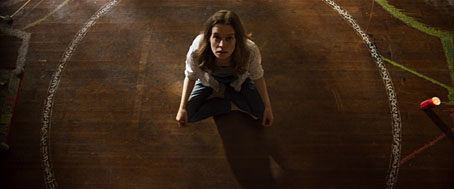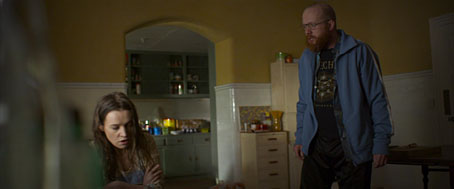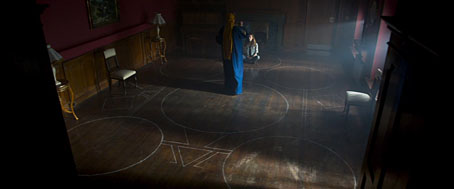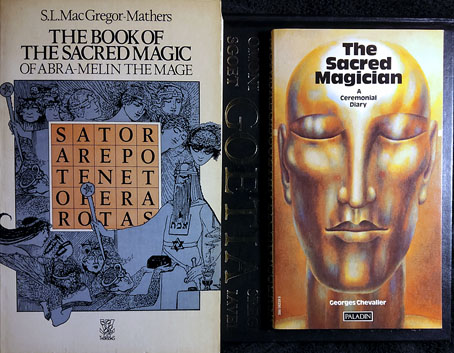Catherine Walker.
Among the Halloween viewing this year was A Dark Song (2016), a debut feature written and directed by Liam Gavin. I’d known about this one for some time thanks to recommendations from friends but for various reasons hadn’t seen it until now. Part of the interest was nakedly egotistical: one of the lead characters wears a T-shirt bearing a design based on the Epigenesis album cover that I created for Melechesh in 2010. The cover art—a variation on the Kabbalistic Tree of Life—suits the occult theme of the film, while Steve Oram’s character is also the kind of person who might be a metal-head.
Steve Oram in that shirt.
Ego matters aside, it’s the occult business that really sets this film apart. Had I known earlier that the story concerns an enactment of the famously arduous Abra-Melin ritual I’d have sought it out much sooner. Catherine Walker plays Sophia, a woman looking for supernatural vengeance following the murder of her young son. Her ritual guide, Oram’s Joseph Solomon, is evidently her last resort after attempts to hire other occultists have failed. Her determination forces her to engage the man despite his obvious unsuitability as a mentor for the Abra-Melin’s psychic assault course. Solomon is a surly recovering alcoholic; once the ritual begins he turns into a belligerent bully. With the pair locked into a remote house that neither of them can leave for fear of the occult consequences, the ensuing battle of wills makes an already hazardous ritual all the more dangerous.
The traditional form of Western occultism, ritual magic, has been treated poorly by the cinema. Rituals on film are usually presented in a shorthand manner derived from Dennis Wheatley, where it’s enough to don a robe and read a couple of lines from a grimoire to have demons manifesting in clouds of smoke. Even when things don’t go the Wheatley route the magical process is seldom allowed much screen time. Doctor Strange announces to the librarian at Kamar-Taj that he’s read a genuine grimoire, The Key of Solomon, together with several other volumes, but we see little evidence of his learning beyond Harry Potter-style fireworks. Magic in the Marvel universe is merely a thaumaturgic martial art, something to add variety to the interminable fight scenes that are the core of all superhero stories. Rosemary’s Baby doesn’t go into much detail about its Satanic working but it does at least give a sense of an operation that involves careful planning and months of effort; it also shows magic at work in a very recognisable and mundane world, something shared with the months-long ritual of A Dark Song. The Abra-Melin is notorious for the physical and mental demands it places on the practitioner. It also incorporates the provision of being something that once begun can’t be backed out of…or so we’re told. Aleister Crowley attempted to perform the ritual in 1903 but abandoned the attempt in order to marry Rose Kelly. John Symonds’ biography of Crowley, The Great Beast (1971), contains a useful description of the operation:
In magic, there have always been two schools, the one invoking the forces of good, the other evoking the forces of evil, or white and black magic. Now, Abra-Melin teaches that the good, or angelic, forces are superior in power to the bad, or satanic forces; and that the latter, as a punishment, have to serve the former. All material effects, all phenomena are the result of the actions of evil spirits working under the directions of good ones. And sometimes the other way round, for bad spirits occasionally manage to escape and, revengefully, do what harm they can. These satanic forces conclude pacts with men and hold them in their power as Mephistopheles held Dr Faustus; for man is the middle nature between angels and demons, and has attendant upon him a Holy Guardian Angel and a Malevolent Demon. The practising magician has therefore to lead a strictly pure life. By prayer and contemplation in a suitable place (an oratory) he can call forth his Holy Guardian Angel, who will instruct him in the right use of the Powers of Darkness. On the other hand, if he fails to steer clear of temptation he will speedily become a prey to the Malevolent Demon and his career will be a series of misfortunes, ending at his death with rapid descent to hell.
There is no general ritual in the magic of Abra-Melin, only lists of angels and demons to be evoked, and of talismans to be consecrated for such purposes as bringing the dead back to life, flying in the air, exciting or quelling tempests, getting gold, or inflaming lust between persons of the magician’s choosing. The snag is that nothing can be done until the Holy Guardian Angel appears “in unequalled beauty” after six months active preparation and tells the aspirant what method to follow for this or that purpose.
Crowley’s boss in the Golden Dawn, SL MacGregor-Mathers, was the first translator of the Abra-Melin ritual into English. Mathers later claimed that when Crowley abandoned the working he gave himself over to the demons that Crowley had unleashed; Crowley disagreed (and, in typical fashion, accused Mathers of having fallen prey to a Malevolent Demon of his own) but it was around this time that Crowley began his experiments with opiates that led to a lifelong heroin addiction. Demons manifest in many forms.
Yes, I happen to have a copy of the Abra-Melin ritual to hand. Doesn’t everyone?
Aleister Crowley’s autobiography is a poor guide to his experience with this ritual, much better is The Sacred Magician (1976), an account in diary form of an enactment of the Abra-Melin in 1973 undertaken by the pseudonymous “Georges Chevalier”. I don’t know of any other accounts as detailed as this one, and given the many difficulties of the ritual it may still be one of the few to be found. What impressed me about A Dark Song was the way the film approached its subject with the same degree of seriousness that Chevalier does; the script is refreshingly free of nods to the audience and wisecracks. The narrative has a familiar shape—a noviciate education at the hands of a browbeating taskmaster—which is complicated by the relationship dynamics. When magic isn’t to the fore, Sophia and Solomon’s war of nerves might be scenes from a deteriorating marriage. Once the ritual begins to work, the peril of their situation escalates accordingly. At the outset of the operation Solomon informs Sophia that magic is important for the knowledge it delivers about the things in the world that science can’t explain. But the names of the two characters are signifiers of wisdom, and the getting of wisdom is the real heart of this story. Liam Gavin’s drama shows how occult cinema can be more than esoteric wrapping on another box of special effects. His film casts a spell, and the chills it summons are authentic ones.
Previously on { feuilleton }
• Llewellyn occult magazine and book catalogue, 1971
• The Art of the Occult
• Calendrier Magique
• Typefaces of the occult revival
• MMM in IT
• The Book of the Lost
• The Occult Explosion
• Rex Ingram’s The Magician
• Forbidden volumes
• The Sapphire Museum of Magic and Occultism
• Occultism for kids





“After the Angel” by Marcus Katz is a pretty good account of an Abramelin ritual working. “Holy Daimon” by Frater Acher is a very good account of an HGA working based on intense Saturn invocation and iterated Abramelin. You’d probably like both.
Since I’m writing, also want to add that I love your art and writing, and found you after buying a print of the Underground Tree of Life which I saw in Promethea.
You’re awesome!
cheers,
Angus
Strangely enough, I was just thinking of this film very recently; I liked its atmosphere and its authenticity and seriousness in depicting the real side of Hermetic magic.
Angus: Thanks! Re: the Abra-Melin, my peak occult book-buying period was in the 1980s. I’ve still got most of the books but aside from listings in newsletters I’m less familiar with the field today so I’m not surprised if there are more sources available. By coincidence (or is it? etc) I was thinking of the Promethea Kabbalah map in relation to the film. Comic and film both contain tiny examples of my work in their narratives, and both those examples are very similar symbols. Steve Oram’s character at one point talks about magic being a map, and it was this idea that I was pursuing with the Kabbalah map. Alan Moore liked the map for the same reason. Curious.
Liam: A cult film of the future, I reckon.
A wonderful review of an equally wonderful (and by that, I mean full of wonder) film. I love the down-to-earth portrayal of Joseph and Sophia as normal, banal humans trying to reach beyond the normal, banal world. Sophia’s ultimate choice is the most humane human thing anyone could do, ironically.
Thanks, Forrest. One of the many subtle things about the script is the way it shows magic as a tool for enlightenment, rather than the common perception of it being all about personal gain. Aleister Crowley was referring to this in one of his more serious statements: “Our method is science, our aim is religion.”
Well, went ahead and watched “A Dark Song” last night with a dubious friend and we both really liked it—thanks for the recommendation! Trying to figure out the right (rite!) word for it as a treatment of the Abramelin. ‘Realistic’ isn’t quite right due to the mixing of many outlandish and sensational and non-Abramelin elements—though I recognize a practicing ceremonial magician who’s done the ritual a few times is surely going to iterate and elaborate. Maybe ‘serious’? Certainly captured the magnitude of the undertaking and a sense of what phenomena and outcomes might be.
Re: map and the Promethea Tree of Life, I quite liked that aspect of your version. I do pathworking on the tree, so fairly often use it literally as a map and it’s nice to have that layer of meaning in the graphic.
And also like the album cover version. It’s elegant for sure, but with 19 connecting lines I also find it a little confusing from a Qabala perspective. And it’s different from some of the older versions of the Tree I’ve seen. Where did you come across it?
Thanks, Angus. The seriousness I was referring to above was the way the ritual (and, by implication, magic in general) was treated seriously on its own terms. But the film is still a horror film so the requirements of the genre also have to be catered to.
I forget the details of the brief for the Melechesh cover but it was the band’s request to have as the main image something that resembled the Tree of Life but wasn’t exactly it. I think they may have supplied me with a sketch since they provided pictorial reference for this and the other covers I’ve done for them. Had it been up to me I probably would have done another variation on the traditional Sephiroth diagram.
I had not looked at your fine blog for a while – I had first learned of your work via Savoy. Returned to it today and promptly watched A Dark Song. Thanks, a fine recommendation. I think the film needs and will bear re-watching.
Thanks, Philip, I’m glad to hear it. I’m looking forward to watching the film again myself.